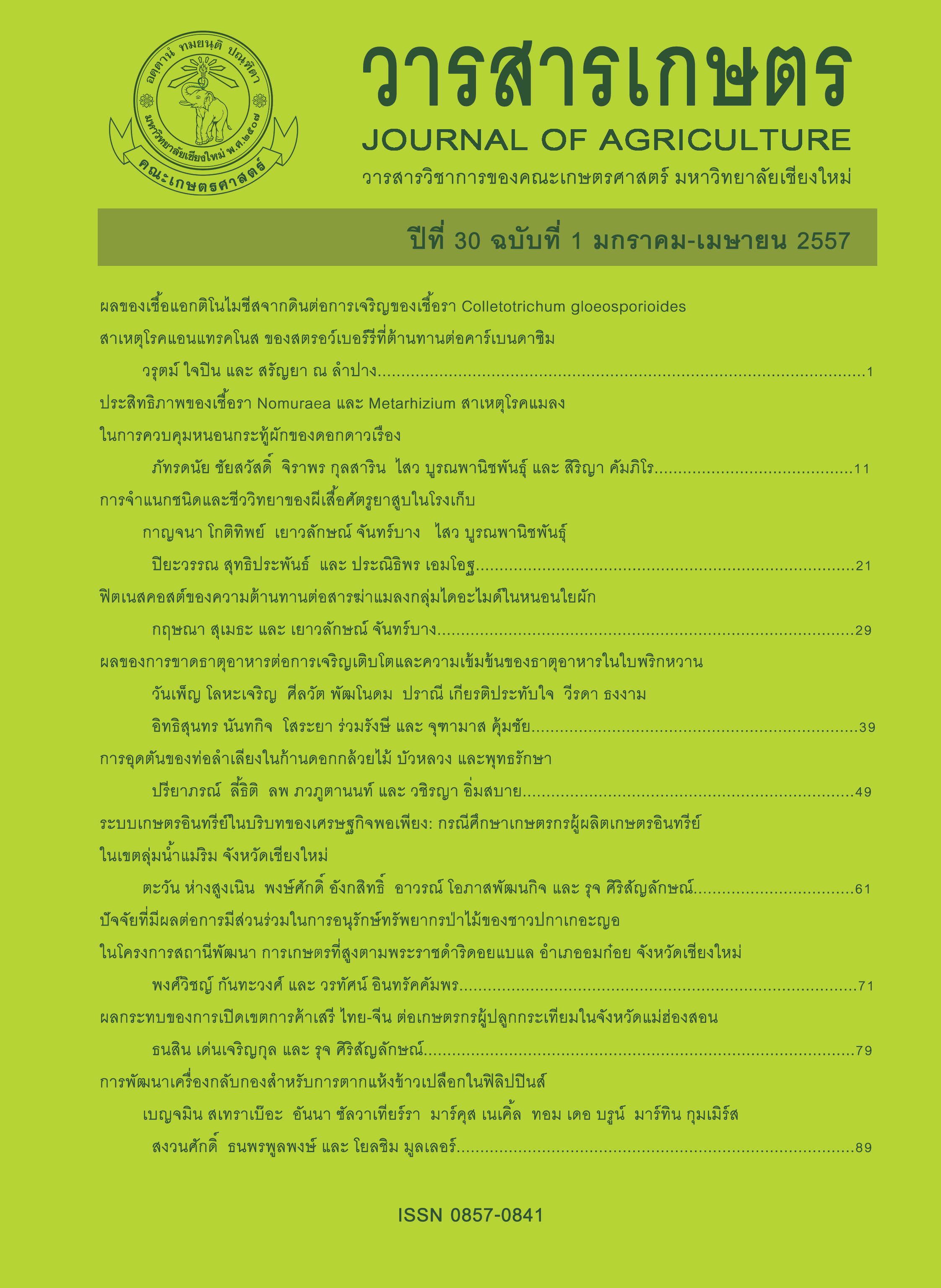Fitness Cost of Resistance to Diamide Insecticide in Diamondback Moth
Main Article Content
Abstract
Diamondback moth (DBM) is the most important insect pest of crucifer crops which is able to develop resistance to several insecticides. The efficacies of diamide insecticide, chlorantraniliprole (CTPR), against DBM larvae collected from Chiang Mai province (Chiang Mai population) and Suphan Buri province (Suphan Buri population) were conducted in laboratory. The results revealed that LC50 of CTPR against Chiang Mai and Suphan Buri populations were 0.1191 and 7.1484 ppm respectively. It was indicated that Suphan Buri population DBM resisted to CTPR about 60 times of Chiang Mai population. In addition, the efficacy of thiamethoxam, neonicotinoid insecticide, was carried out. Suphan Buri population did not resist to thiamethoxam more than Chiang Mai population due to the resistance ratio was only 9 folds. The assessment of survival and reproduction of Suphan Buri population (resistant population) was similar to Chiang Mai population (susceptible population) regarding to the rate of oviposition, egg hatching, period of growth and development, sex ratio and survival rate, except Suphan Buri population took longer developmental period in the first and the fourth larval instars than the other.
Article Details
References
คณิตา ทองเจริญ วีรเทพ พงษ์ประเสริฐ ไสว บูรณพานิชพันธุ์ และ จิราพร ตยุติวุฒิกุล. 2552. ประสิทธิภาพของสารฆ่าแมลงบางชนิดที่มีต่อหนอนใยผักในเขตภาคเหนือตอนล่างของประเทศไทย.วารสารเกษตร 25(3): 245-255.
พรรณเพ็ญ ชโยภาส ปิยรัตน์ เขียนมีสุข ทวีศักดิ์ ชโยภาส และ จิราภรณ์ ทองพันธ์. 2543. การตรวจความต้านทานต่อสารฆ่าแมลงของหนอนใยผัก. น. 233-247. ใน: แมลงและสัตว์ศัตรูพืช. การประชุมวิชาการแมลงและสัตว์ศัตรูพืช ครั้งที่ 12. กองกีฏและสัตววิทยา กรมวิชาการเกษตร, กรุงเทพฯ.
วิโรจน์ สุนทรภัค ประพนธ์ ไทยวานิช และ ศุภลักษณ์ กลับน่วม. 2554. คลีนิกพืช: พืชตระกูลกะหล่ำและผักกาด. (ระบบออนไลน์). แหล่งข้อมูล: http://forecast.doae.go.th/web/agrotis.html (2 มิถุนายน 2554).
วีรเทพ พงษ์ประเสริฐ. 2536. ทิศทางของการวิจัยเพื่อควบคุมหนอนใยผักในประเทศไทย. กองวิเคราะห์โครงการและประเมินผล สำนักงานคณะกรรมการวิจัยแห่งชาติ, กรุงเทพฯ. 100 หน้า.
สุภราดา สุคนธาภิรมย์ ณ พัทลุง สมศักดิ์ ศิริพล ตั้งมั่น วนาพร วงษ์นิคง พวงผกา อ่างมณี ศรุต สุทธิอารมณ์ และ เกรียงไกร จำเริญมา. 2554. การพยากรณ์ความต้านทานต่อสารฆ่าแมลงของหนอนใยผักเพื่อการบริหารจัดการศัตรูพืชในระดับท้องที่. (ระบบออนไลน์). แหล่งข้อมูล: http://it.doa.go.th/refs/files/ 1860_2554.pdf?PHPSESSID=b236b77eb65ea315ba8fc8bc20d1d20a (21 มิถุนายน 2554).
Abbott, W. S. 1925. Method for computing the effectiveness of an insecticide. Journal of Economic Entomology 18: 256-267.
Abro, G. H., R. A. Soomro and T. S. Syed. 1992. Biology and behavior of diamondback moth Plutella xylostella (L.). Pakistan Journal of Zoology 24: 7-10.
Aaron, J. G., Y. Carriere and B. E. Tabashnik. 2009. Fitness costs of insect resistance to Bacillus thuringiensis. Annual Review of Entomology 54: 147-163.
Alyokhin, A. V. and D. N. Ferro. 1999. Relative fitness of Colorado potato beetle (Coleoptera: Chrysomelidae) resistant and susceptible to the Bacillus thuringiensis Cry3A toxin. Journal of Economic Entomology 92(3): 510-515.
Carriere, Y., C. Ellers-Kirt, A. L. Patin, M. A. Sims, S. Meyer, Y. B. Liu, T. J. Dennehy and B. E. Tabashnik. 2001. Overwintering cost associated with resistance to transgenic cotton in the pink bollworm (Lepidoptera: Gelechiidae). Journal of Economic Entomology 94(4): 935-941.
Chevillon, C., D. Bourguet., F. Rousset, N. Pasteur and M. Raymond. 1997. Pleiotropy of adaptive changes in populations: comparisons among insecticide resistance genes in Culex pipiens. Genetical Research 70: 195-204.
Harcourt, D. G. 1957. Biology of diamondback moth Plutella maculippenis (Curt.) (Lepidoptera: Plutellidae) in eastern Ontario. II. Life-history, behavior, and host relationships. The Canadian Entomologist 89(12): 554-564.
IRAC. 2009. Susceptibility test methods series method No: 018. (Online). Available: http://www.irac-online.org/wp-content/uploads/2009/09/method_018_v3.4_Mar10.pdf (June 22, 2011).
IRAC. 2010. Insecticide resistance management global guidelines for IRAC group 28 (diamide) insecticides. (Online). Available: http://www.irac-online.org/wp-content/uploads/2009/09/Global_IRM_Guidelines_Group-28_v2.1.pdf (June 2, 2011).
IRAC. 2012. The IRAC International Diamide Working Group. (Online). Available: Diamide_poster_v4_10May12.pdf (June 22, 2011).
Li Z. M., S. S. Liu, Y. Q. Liu and G. Y. Ye. 2007. Temperature-related fitness costs of resistance to spinosad in the diamondback moth, Plutella xylostella (Lepidoptera: Plutellidae). Bulletin of Entomological Research 97(6): 627-635.
Maa, C. J. W. 1986. Ecological approach to male diamondback moth response to sex pheromone. (Online). Available: http://web.entomology.cornell.edu/shelton/diamondback-moth/pdf/85papers/ 1985DBM12. pdf (June 22, 2011).
McKenzie, J. A. 1990. Selection at the dieldrin resistance locus in overwintering populations of Lucilia cuprina (Wiedemann). Australian Journal of Zoology 38: 493-501.
Sayyed, A. H., M. R. Rizvi and A. H. Alvi. 2002. Management of diamondback moth, Plutella xylostella (Lepidoptera: Plutellidae): a lesson from South East Asia for sustainable integrated pest management. Pakistan Journal of Biological Sciences 5: 234-245.
Subramanyam, B. and D. W. Hagstrum. 1995. Resistance measurement and management. pp. 331-397 In: B. Subramanyam and D. W. Hagstrum (eds.). Integrated Management of Insects in Stored Products. Marcel Dekker, Inc., New York.
Sukonthabhirom, S., D. Dumrongsak, S. Jumroon, T. Saroch, A. Chaweng and T. Tanaka. 2009. Update on DBM diamide resistance from Thailand: causal factors and learnings. (Online). Available: http://www.irac-online.org/wp-content/uploads/2009/09/DBM_Workshop_Diamide-_DBM_Resistance_Thailand.pdf (June 22, 2011).
Tabashnik, B. E., T. J. Dennehyand Y. Carriere. 2005. Delayed resistance to transgenic cotton in pink bollworm. (Online). Available: http://www.pnas.org/content/102/43/15389.full.pdf (June 22, 2011).
Talekar, N. S. and A. M. Shelton. 1993. Biology, ecology and management of the diamondback moth. Annual Review of Entomology 38: 275-301.
Wang, X., X. Li, A. Shen and Y. Wu. 2010. Baseline susceptibility of the diamondback moth (Lepidoptera: Plutellidae) to chlorantraniliprole in China. Journal of Economic Entomology 103(3): 843-848.
Waterhouse, D. F. and K. R. Norris. 1987. Biological Control: Pacific Prospects. Inkata Press, Melbourne. 454 p.
Whalon, M. E., D. Mota-Sanchez and L. Duynslager. 2011. Resistance species profile: Plutella xylostella. (Online). Available: http://www.pesticideresistance.org/search/12/0/571/ (June 22, 2011).
Wyss, C. F., H. P. Young, J. Shukla and R. M. Roe. 2003. Biology and genetics of a laboratory strain of the tobacco budworm, Heliothis virescens (Lepidoptera: Noctuidae), highly resistant to spinosad. Crop Protection 22(2): 307-314.


